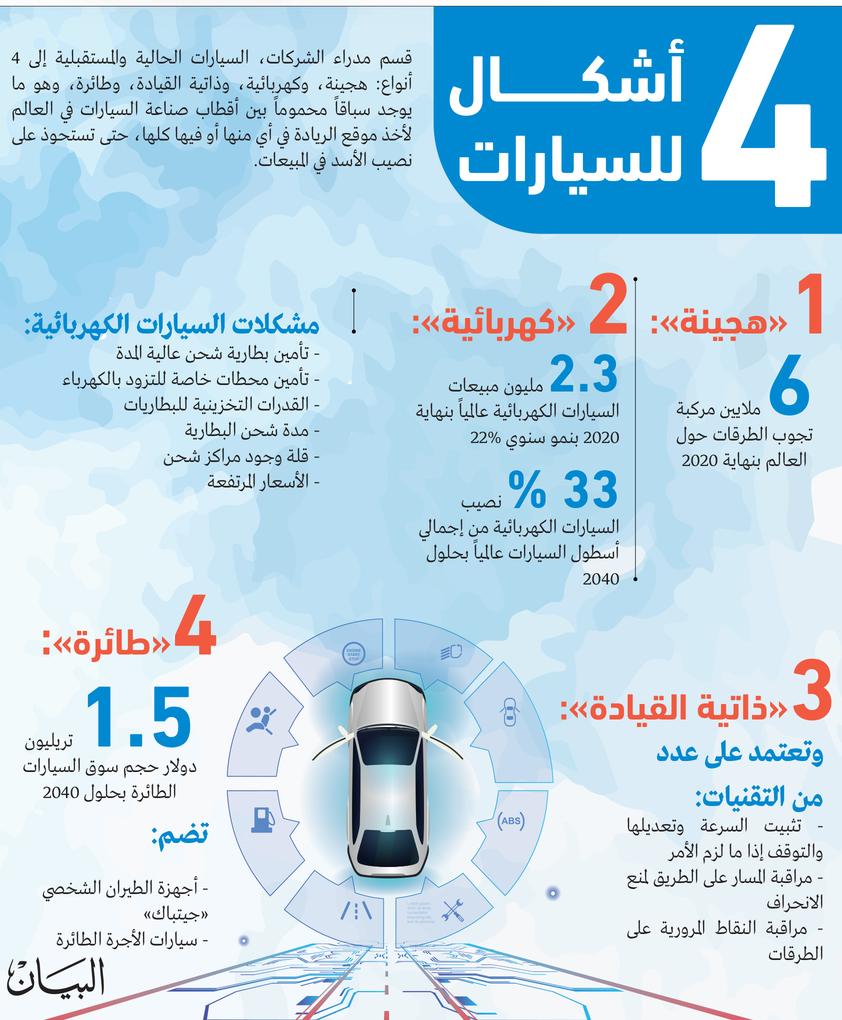Managers working in major car companies in the UAE confirmed that technology will drive the cars of the future, which will be like “smart phones walking on wheels.” It will be outfitted with hundreds of microcomputers, putting the industry on the cusp of revolutionary changes it hasn't seen in more than a century.
They said that there are 10 advantages that will drive the cars of the future, namely: the presence of a large database, endless entertainment, a complete end to the era of keys, a great use of artificial intelligence, the adoption of fifth-generation technologies, touch screens everywhere, and a voice assistant to meet commands, It has state-of-the-art navigation systems, permanent internet access, and many mirror-replacement cameras.
The “Economic Statement” surveyed the views of the managers of major car companies in the UAE about what the cars of the future will be, as they confirmed that they will include large information and entertainment systems, as they are likely to include a larger and more accurate information and entertainment system than anything we see currently, which allows us to work or Watching something while going to our destination. They expected that by 2025 there will be no keys and that the process of riding the car will depend on recognizing its driver as soon as he approaches it through fully digital 3D interfaces that perform these tasks.
The managers pointed out that the auto industry in the future will use the amazing progress in the amazing technologies that the world is witnessing today, such as the fifth generation technology, and modern touch screens instead of buttons and keys, even the idea of communicating with cars will be done through a personal assistant in the form of “hologram”. Three-dimensionality through which the driver can request multiple services, and the use of navigation systems to guide the car to the desired point will be through systems displayed on the front windows that are permanently connected to the Internet, and ensure navigation information, not only the shortest and least congested path, but also linking systems Navigation and road surface suspension to provide a smooth ride that eliminates potholes and vibration from affecting the passenger compartment.
Transformation
Michel Ayat, CEO of the Arab Automobile Company, said that the technological transformation will be the main player in the sector in the coming years. For 50 years, the car market has been a traditional market in the buying and selling process, but the next five years, the market will witness a radical transformation, He had not seen it in half a century.
He added: The customer now does not need to go to the car showroom to find out the car he wants, and it is enough for him to click on his phone or on the computer, to know everything about the car he wants to buy, its specifications, and its price, without having to visit the showroom, except to try it out before buying. And before that, he had already made his decision. The proof of this is that visitors to car showrooms have decreased by up to 50%, and the coming years will witness a major change in the world of cars, which we have not seen before.
He added that the technological development has affected the automotive sector, like other sectors, where we find that modern cars have become dependent on artificial intelligence, and make the driver connected to everything around him, and he explores seeing everything in a 360-degree angle.
Technological development has also made the car linked to other cars, or its service centers, to know everything about the car, as well as the amazing and accelerating trend in the electric and self-driving cars industry.
"City of the Future"
Vincent Weinen, Senior Managing Director of the UAE Market at Al-Futtaim Motors, said: Toyota Motor in all its divisions, including Lexus, is working on plans to create a “city of the future”, where it will test many new means of transportation and artificial intelligence technology such as robots, Self-mobilization, smart homes on the ground. The ambitious project, called Woven Town, is set to begin next year.
He added: As for the concept of self-driving cars, the Toyota Group, including the Lexus brand, plans to launch new self-driving vehicles when the time is right. Also, all Lexus vehicles currently support advanced technologies that fall within the first stage of the self-driving system, and include safety systems such as the lane departure warning system and adaptive cruise control, whose presence is essential for the manufacture of self-driving cars.
competitive
Victor Dalmau, CEO of “Volkswagen Middle East”, said that the auto sector will develop amazingly in the coming years, as the market has become more competitive than ever, and the new normal has imposed challenges on global economies with low customer demand and unforeseen changes. precedents in consumer behavior. These factors had exceptional effects on the auto industry, prompting all car companies to reassess their business operations.
He added, "For our part, Volkswagen will remain committed to our digital strategy with an emphasis on quality and simplicity as key features that our products offer to customers." This strategy will strengthen our brand and lead the luxury car segment based on sales volume in the region.
"hybrid"
The managers divided the cars into 4 types: hybrid, electric, self-driving, and aircraft, which creates a frantic race between the poles of the auto industry in the world to take the leadership position in any or all of them in order to capture the lion's share of future car sales.
They said that the development began with hybrid cars that combine internal combustion and the presence of a battery that helps each other, but the managers expected its disappearance due to the trend towards fully electric cars, whose technologies are witnessing amazing progress, and major players such as the American company "Tesla" have emerged. Reports issued by the International Energy Agency revealed that by the end of 2020, the number of hybrid vehicles reached about 6 million vehicles around the world.


«Electric»
The managers said that the second type of future car is electric, which major companies are working on at the present time. They pointed out that sales of electric cars in all countries of the world rose to about 2.3 million cars by the end of 2020, a growth of about 22% compared to sales in the same period last year, which amounted to 1.76 million cars.
Bloomberg New Energy Finance also predicted that by 2040 electric cars will represent about 33% of the total global car fleet and 55% of total new car sales.
The managers saw that the electric car industry faces a series of obstacles to speed up its pace, foremost of which is securing a high-duration charging battery as well as special stations for supplying electricity.
They said that despite the increasing popularity of the idea of owning electric cars in different segments around the world, the storage capabilities of the batteries are still a factor that worries everyone who wants to own this type of car, and there is also another big problem, related to the charging period of the car battery itself, which is still It requires time, which is not commensurate with the speed required to complete all forms of work that are based on the car.
Another negative reason is the lack of car charging centers. Another problem is the high prices, as these cars are still more expensive than those that run on conventional fuel.
Companies are racing to produce electric cars, for example, the first of the next generation of battery electric cars from Kia will be unveiled in the first quarter of 2021, and the next car will embody Kia's focus shift towards electric power.
“We want our products to provide a unique and natural experience that enables them to enhance the everyday lives of our customers,” said Karim Habib, Senior Vice President and Head of the Global Design Center at Kia. Our goal is to design a unique physical presence for our brand, creating original, innovative and exciting electric vehicles.
"self-driving"
As for the third type of vehicles, it is self-driving cars. Some used to see this as a fantasy to see a car running on the street without any human intervention, but thanks to the tireless efforts that are being made in this field, today it is closer to us than ever before. .
Major companies around the world have entered the stages of experiments with self-driving car technologies, and the world of the car industry has also invaded roadside assistance technologies such as the active cruise control system that is able to monitor traffic in front of the car and adjust the speed and stop if necessary, and lane monitoring technology on the road to prevent deviation The vehicle is deviated from its lane, traffic sign monitoring systems on the roads, maximum and minimum speeds, and other technologies.
Although the commercial appearance of these technologies under the heading of “assistive technologies” and not fully automated technologies, it represents a first step towards reaching the commercial production of fully self-driving cars.
Some believe that among the advantages of self-driving cars is safety, according to statistics, more than 1.3 million people die annually due to traffic accidents, and 94% of these accidents are caused by human errors. Without being affected by factors such as fatigue or drowsiness that may affect a person while driving.
But the problem of accepting and adopting such technology by users remains the biggest problem. It is difficult to convince users to leave the steering wheel of a computer that is driving the car and reach the specified destination. According to statistics, we find that 45% of motorists refuse to have their car self-driving, while Only 15% would like to switch to a self-driving car.
Flying vehicles... a fantasy come true
“Flying cars” were a fantasy in the past, but it has become a reality now, after many flying vehicles have already been developed, ranging from personal flying devices or so-called “jetpacs” to flying taxis.
Advances in battery capacity, materials science, and computer simulation systems have paved the way for the development of a range of flying vehicles, from electric gliders to fixed-wing aircraft and unmanned quadcopters.
Most flying vehicles include propellers instead of wings to allow them to take off and land vertically, tilted propellers increase the efficiency of the aircraft in flying longer distances, and aircraft with multiple propellers are designed to reduce noise when flying. Most importantly, these vehicles are a faster mode of transportation compared to traditional transportation, especially in crowded cities.
Dozens of start-ups are currently competing to develop personal flying devices (Jetpacks), flying motorcycles, and personal flying taxis. Airlines, car manufacturers, investors and financiers are searching for a foothold in this market, which is expected to be worth about $1.5 trillion in 2040.
Follow the economic statement via Google News
Print Email Facebook Twitter Linkedin Pin Interest Whats App